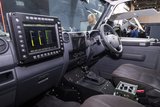Hensoldt, Huneed Technologies team for Mode 5
Hensoldt and Korea's Huneed Technologies have signed a cooperation agreement for the localisation of identification-friend-or-foe (IFF) Mode 5 equipment for the Korean armed forces, Hensoldt announced on 28 November.
IFF systems allow ships and aircraft to be identified precisely by automatically sending interrogation signals, which are answered by transponders on board friendly units. This allows field commanders to quickly distinguish friendly from hostile forces. The Mode 5 standard employs encryption techniques to avoid hostile manipulation of the signal.
The Korean armed forces, like all US and NATO allies, is upgrading the IFF equipment of its aircraft, ships and air defence systems from the existing Mode 4 to the new Mode 5 standard. Post 2020 joint missions with US armed forces will be possible only for units with Mode 5-capable equipment.
Huneed has already proven its ability to manufacture and integrate the LTR 400 IFF transponder, which has been adapted to the specific requirements of the South Korean armed forces.
In Korea, Hensoldt has equipped the identification system of the new multirole tanker aircraft with Mode 5-capable encryption devices and has already provided the Korean Air Force and Army’s low altitude radars with its IFF Mode 5 technology in cooperation with local Korean industry.
Thomas Müller, CEO, Hensoldt, said: ‘We are committed to bring the latest-technology capabilities in IFF into the upcoming IFF performance improvement programme of the South Korean armed forces which will improve the distinction between friendly and hostile forces and thus help to avoid friendly fire.
‘I am proud that our companies have already succeeded in the localisation of the first IFF transponder according to the needs of the Korean armed forces.’
Related Equipment in Defence Insight
More from Digital Battlespace
-
![Babcock nears first customer for Nomad AI translation tool]()
Babcock nears first customer for Nomad AI translation tool
Nomad can provide militaries with real-time intelligence, saving critical time on the battlefield.
-
![AUSA 2025: Israel’s Asio Technologies to supply hundreds of improved Taurus tactical systems]()
AUSA 2025: Israel’s Asio Technologies to supply hundreds of improved Taurus tactical systems
Taurus operates alongside the Israel Defense Forces’ Orion system which supports mission management across tens of thousands of manoeuvring forces, from squad leaders to battalion commanders.
-
![AUSA 2025: Kopin pushes micro-LED plans as China moves faster]()
AUSA 2025: Kopin pushes micro-LED plans as China moves faster
The plan for the new displays follows fresh investment in Kopin’s European facilities by Theon and an order for head-up displays in fielded aircraft, with funding from the US Department of Defense.
-
![AUSA 2025: Persistent Systems to complete its largest order by year’s end]()
AUSA 2025: Persistent Systems to complete its largest order by year’s end
Persistent Systems received its largest ever single order for its MPU5 devices and other systems earlier this month and has already delivered the 50 units to the US Army’s 4th Infantry Division.
-
![Aselsan brings in dozens of companies and systems under the Steel Dome umbrella]()
Aselsan brings in dozens of companies and systems under the Steel Dome umbrella
Turkey has joined the family of countries attempting to establish a multilayered air defence system with government approval in August 2024 for the effort landed by Aselsan. Dubbed Steel Dome, the programme joins Israel’s Iron Dome, the US Golden Dome, India’s Mission Sudarshan Chakra and South Korea’s low-altitude missile defence system.
-
![DSEI 2025: MARSS unveils new agnostic multidomain C4 system]()
DSEI 2025: MARSS unveils new agnostic multidomain C4 system
MARSS’ NiDAR system has been deployed using sensors from static platforms to provide detection and protection for static sights, such as critical infrastructure, ports and military bases.




























